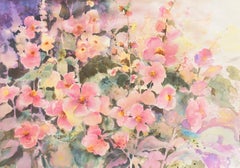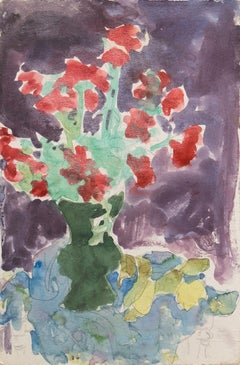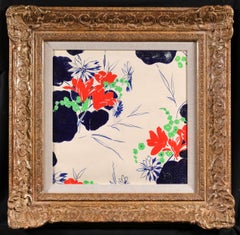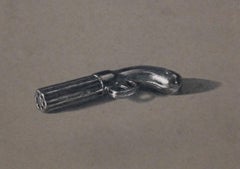Laid Paper Still-life Drawings and Watercolors
to
1
1
Overall Width
to
Overall Height
to
2
1
1
7
4
2
1
1
1
1
1
1
1
1
1
1
980
29
25
25
17
1
1
2
Style: Post-Impressionist
Medium: Laid Paper
'Pink Daisies', California Watercolor Society, SWA, Woman Artist, Zoltan Szabo
By Beverly Fields
Located in Santa Cruz, CA
Signed lower right, 'Beverly Fields' (American, 20th century) and painted circa 1985.
This listed California artist has exhibited widely and with success and is the recipient of num...
Category
1980s Post-Impressionist Laid Paper Still-life Drawings and Watercolors
Materials
Watercolor, Laid Paper
'Sweet Peas', Louvre, Paris, Académie Chaumière, LACMA, SFAA, Carmel, California
Located in Santa Cruz, CA
'Sweet Peas' by Victor Di Gesu.
Louvre, Paris, Académie Chaumière, Los Angeles County Museum of Art, Carmel Art Association, California
-----
Painted circa 1955 by Victor Di Gesu (A...
Category
1950s Post-Impressionist Laid Paper Still-life Drawings and Watercolors
Materials
Watercolor, Laid Paper, Pencil, Gouache
Related Items
Projet de Tissus - Fauvist Flowers Watercolor & Gouache by Raoul Dufy
By Raoul Dufy
Located in Marlow, Buckinghamshire
Botanical watercolour and gouache on paper circa 1920 by French fauvist painter Raoul Dufy. The work depicts flowers in red, blue and green. This work was executed by Dufy as a fabric design.
Dimensions:
Framed: 19.5"x19.5"
Unframed: 12"x12"
Provenance:
Private collection of works by Raoul Dufy for Bianchini Ferier
Bianchini Ferrier Collection - Christie's London - July 2001
SF Fall Show
Raoul Dufy was one of a family of nine children, including five sisters and a younger brother, Jean Dufy, also destined to become a painter. Their father was an accountant in the employ of a major company in Le Havre. The Dufy family was musically gifted: his father was an organist, as was his brother Léon, and his youngest brother Gaston was an accomplished flautist who later worked as a music critic in Paris. Raoul Dufy's studies were interrupted at the age of 14, when he had to contribute to the family income. He took a job with an importer of Brazilian coffee, but still found time from 1892 to attend evening courses in drawing and composition at the local college of fine arts under Charles Marie Lhullier, former teacher of Othon Friesz and Georges Braque. He spent his free time in museums, admiring the paintings of Eugène Boudin in Le Havre and The Justice of Trajan in Rouen. A municipal scholarship enabled him to leave for Paris in 1900, where he lodged initially with Othon Friesz. He was accepted by the École des Beaux-Arts, where he studied under Léon Bonnat, whose innate conservatism prompted Dufy to remark later that it was 'good to be at the Beaux-Arts providing one knew one could leave'.
And leave he did, four years later, embarking with friends and fellow students on the rounds of the major Paris galleries - Ambroise Vollard, Durand-Ruel, Eugène Blot and Berheim-Jeune. For Dufy and his contemporaries, Impressionism represented a rejection of sterile academism in favour of the open-air canvases of Manet, the light and bright colours of the Impressionists, and, beyond them, the daringly innovative work of Gauguin and Van Gogh, Seurat, Cézanne, Toulouse-Lautrec and others. Dufy was an out-and-out individualist, however, and was not tempted to imitate any of these artists. He produced, between 1935 and 1937, Fée Electricité (Spirit of Electricity), the emblem for the French utilities company Electricité de France (EDF).
Dufy visited the USA for the first time in 1937, as a member of the Carnegie Prize jury. In 1940, the outbreak of war (and his increasingly rheumatic condition) persuaded him to settle in Nice. When he eventually returned to Paris 10 years later, his rheumatism had become so debilitating that he immediately left for Boston to follow a course of pioneering anti-cortisone treatment. He continued working, however, spending time first in Harvard and then in New York City before moving to the drier climate of Tucson, Arizona. The cortisone treatment was by and large unsuccessful, although he did recover the use of his fingers. He returned to Paris in 1951 and decided to settle in Forcalquier, where the climate was more clement. Within a short time, however, he was wheelchair-bound. He died in Forcalquier in March 1953 and was buried in Cimiez.
Between 1895 and 1898, Raoul Dufy painted watercolours of landscapes near his native Le Havre and around Honfleur and Falaise. By the turn of the century, however, he was already painting certain subjects that were to become hallmarks of his work - flag-decked Parisian cityscapes, Normandy beaches teeming with visitors, regattas and the like, including one of his better-known early works, Landing Stage at Ste-Adresse. By 1905-1906 Friesz, Braque, Matisse, Derain, Vlaminck, Van Dongen and Rouault were described collectively as Fauves (the wild beasts). What they had in common was a desire to innovate, but they felt constrained nonetheless to meet formally to set out the guiding principles of what promised to be a new 'movement'. Dufy quickly established that those principles were acceptable; moreover, he was most impressed by one particular painting by Henri Matisse ( Luxury, Calm and Voluptuousness) which, to Dufy, embodied both novelty and a sense of artistic freedom. Dufy promptly aligned himself with the Fauves. Together with Albert Marquet in particular, he spent his time travelling the Normandy coast and painting views similar...
Category
1920s Fauvist Laid Paper Still-life Drawings and Watercolors
Materials
Paper, Watercolor, Gouache
$12,775
H 19.5 in W 19.5 in
Gun from Clue
By A.J. Fries
Located in Buffalo, NY
An original mixed media drawing by American artist A.J. Fries.
Category
21st Century and Contemporary Realist Laid Paper Still-life Drawings and Watercolors
Materials
Gouache, Graphite, Paper
The Terrace
Located in London, GB
'The Terrace', watercolour on art paper, by Maurice Savin (circa 1950s). An inviting scene from the South of France depicts a quiet sun terrace on a balmy day with azure skies. The v...
Category
1950s Modern Laid Paper Still-life Drawings and Watercolors
Materials
Paper, Watercolor
Botanical Study Autumn Grape Leaves #2
By Les Anderson
Located in Soquel, CA
Colorful study of grape leaves in autumn with abstracted elements and a pink/magenta background by California artist Les (Leslie Luverne) Anderson (American, 1928-2009). From the est...
Category
Late 20th Century American Impressionist Laid Paper Still-life Drawings and Watercolors
Materials
Watercolor, Laid Paper
$187 Sale Price
50% Off
H 15 in W 23 in D 1 in
Lily Pads and Lotus Flowers
Located in Soquel, CA
Delicate watercolor of lilies in a pond by an unknown artist (20th Century). Two flowers are blooming above lily pads in a pond. The flowers are rendered in a soft pink, whereas the ...
Category
21st Century and Contemporary American Impressionist Laid Paper Still-life Drawings and Watercolors
Materials
Paper, Watercolor
Bearded Irises - Floral Garden Watercolor Still-Life
By Jean Warren
Located in Soquel, CA
Lovely abstracted floral watercolor painting of bearded irises by artist Jean Warren (American, b. 1945). Signed "J. Warren" lower edge, bi...
Category
1980s American Impressionist Laid Paper Still-life Drawings and Watercolors
Materials
Watercolor, Laid Paper
$760 Sale Price
20% Off
H 33 in W 40.5 in D 1 in
French Neo-Impressionist Still Life Pointillist Mid 20th Century Painting
By Louis Bellon
Located in Cirencester, Gloucestershire
Neo Impressionist Still Life
by Louis Bellon (French 1908-1998)
signed lower right
gouache painting on paper, unframed
measurements: 10 x 12.75 inche...
Category
Mid-20th Century Pointillist Laid Paper Still-life Drawings and Watercolors
Materials
Gouache
$1,062 Sale Price
30% Off
H 10 in W 12.75 in
Rick Owens Hollywood show. From the Fashion series
Located in Miami Beach, FL
The artist has covered New York collections for over 16 years and has interviewed, as a journalist, several fashion designers and personalities for different publications. He loves t...
Category
21st Century and Contemporary Contemporary Laid Paper Still-life Drawings and Watercolors
Materials
Paper, Pencil, Gouache
$650
H 15 in W 11 in D 0.1 in
19th Century Italian Floral Wallpaper Painting
Located in Lake Worth Beach, FL
Architectural Floral Wallpaper Fragment
19th Century Italian hand painted floral design wallpaper lined with linen, in gold leaf framed.
Category
19th Century Italian School Laid Paper Still-life Drawings and Watercolors
Materials
Watercolor, Gouache, Laid Paper, Linen
Projet de Fleurs - Fauvist Flowers Gouache by Raoul Dufy
By Raoul Dufy
Located in Marlow, Buckinghamshire
Botanical gouache on paper circa 1920 by French fauvist painter Raoul Dufy. The work flowers in red and blues with green foliage against a yellow and white stripped background.
Dimensions:
Framed: 25"x20"
Unframed: 18"x13"
Raoul Dufy was one of a family of nine children, including five sisters and a younger brother, Jean Dufy, also destined to become a painter. Their father was an accountant in the employ of a major company in Le Havre. The Dufy family was musically gifted: his father was an organist, as was his brother Léon, and his youngest brother Gaston was an accomplished flautist who later worked as a music critic in Paris. Raoul Dufy's studies were interrupted at the age of 14, when he had to contribute to the family income. He took a job with an importer of Brazilian coffee, but still found time from 1892 to attend evening courses in drawing and composition at the local college of fine arts under Charles Marie Lhullier, former teacher of Othon Friesz and Georges Braque. He spent his free time in museums, admiring the paintings of Eugène Boudin in Le Havre and The Justice of Trajan in Rouen. A municipal scholarship enabled him to leave for Paris in 1900, where he lodged initially with Othon Friesz. He was accepted by the École des Beaux-Arts, where he studied under Léon Bonnat, whose innate conservatism prompted Dufy to remark later that it was 'good to be at the Beaux-Arts providing one knew one could leave'.
And leave he did, four years later, embarking with friends and fellow students on the rounds of the major Paris galleries - Ambroise Vollard, Durand-Ruel, Eugène Blot and Berheim-Jeune. For Dufy and his contemporaries, Impressionism represented a rejection of sterile academism in favour of the open-air canvases of Manet, the light and bright colours of the Impressionists, and, beyond them, the daringly innovative work of Gauguin and Van Gogh, Seurat, Cézanne, Toulouse-Lautrec and others. Dufy was an out-and-out individualist, however, and was not tempted to imitate any of these artists. He produced, between 1935 and 1937, Fée Electricité (Spirit of Electricity), the emblem for the French utilities company Electricité de France (EDF).
Dufy visited the USA for the first time in 1937, as a member of the Carnegie Prize jury. In 1940, the outbreak of war (and his increasingly rheumatic condition) persuaded him to settle in Nice. When he eventually returned to Paris 10 years later, his rheumatism had become so debilitating that he immediately left for Boston to follow a course of pioneering anti-cortisone treatment. He continued working, however, spending time first in Harvard and then in New York City before moving to the drier climate of Tucson, Arizona. The cortisone treatment was by and large unsuccessful, although he did recover the use of his fingers. He returned to Paris in 1951 and decided to settle in Forcalquier, where the climate was more clement. Within a short time, however, he was wheelchair-bound. He died in Forcalquier in March 1953 and was buried in Cimiez.
Between 1895 and 1898, Raoul Dufy painted watercolours of landscapes near his native Le Havre and around Honfleur and Falaise. By the turn of the century, however, he was already painting certain subjects that were to become hallmarks of his work - flag-decked Parisian cityscapes, Normandy beaches teeming with visitors, regattas and the like, including one of his better-known early works, Landing Stage at Ste-Adresse. By 1905-1906 Friesz, Braque, Matisse, Derain, Vlaminck, Van Dongen and Rouault were described collectively as Fauves (the wild beasts). What they had in common was a desire to innovate, but they felt constrained nonetheless to meet formally to set out the guiding principles of what promised to be a new 'movement'. Dufy quickly established that those principles were acceptable; moreover, he was most impressed by one particular painting by Henri Matisse ( Luxury, Calm and Voluptuousness) which, to Dufy, embodied both novelty and a sense of artistic freedom. Dufy promptly aligned himself with the Fauves. Together with Albert Marquet in particular, he spent his time travelling the Normandy coast and painting views similar...
Category
1920s Fauvist Laid Paper Still-life Drawings and Watercolors
Materials
Gouache, Paper
Flower Pot, Impressionist Gouache Painting by Eugene Baboulene
By Eugene Baboulene
Located in Long Island City, NY
Artist: Eugene Baboulene, French (1905 - 1994)
Title: Flower Pot
Year: circa 1960
Medium: Gouache on Paper, signed and dedicated l.r.
Size: 20 in. x 13 in. ...
Category
1960s Post-Impressionist Laid Paper Still-life Drawings and Watercolors
Materials
Gouache
Antique American Floral Still Life of Roses, Delicately Rendered
Located in Grand Rapids, MI
Antique Floral Still Life of Roses, Delicatly Rendered
American, 19th/20th Century
Signed: A. Ziffel 1906 (Lower, Right)
" Still Life of Roses ", 1906
Watercolor and Gouache on...
Category
Early 20th Century Laid Paper Still-life Drawings and Watercolors
Materials
Paper, Watercolor, Gouache, Graphite
Laid Paper still-life drawings and watercolors for sale on 1stDibs.
Find a wide variety of authentic Laid Paper still-life drawings and watercolors available on 1stDibs. While artists have worked in this medium across a range of time periods, art made with this material during the 21st Century is especially popular. If you’re looking to add still-life drawings and watercolors created with this material to introduce a provocative pop of color and texture to an otherwise neutral space in your home, the works available on 1stDibs include elements of blue, orange and other colors. There are many well-known artists whose body of work includes ceramic sculptures. Popular artists on 1stDibs associated with pieces like this include Evelyne Brigeois, Barbara Gibson, Benjamin G. Benno, and Beverly Fields. Frequently made by artists working in the Impressionist, Post-Impressionist, all of these pieces for sale are unique and many will draw the attention of guests in your home. Not every interior allows for large Laid Paper still-life drawings and watercolors, so small editions measuring 0.1 inches across are also available Prices for still-life drawings and watercolors made by famous or emerging artists can differ depending on medium, time period and other attributes. On 1stDibs, the price for these items starts at $38 and tops out at $1,450,000, while the average work can sell for $982.
Recently Viewed
View AllMore Ways To Browse
Vintage Cunard Posters
Vintage Driving Hat
Vintage Greyhound Poster
Vintage Showgirls Art
Vintage Water Ski Poster
W C Griffiths
William Steeple Davis
Wolf Fur Coat
Zinkeisen Doris
18 Th Century Oil On Canvas
Adolf Dehn Spring In Central Park
Ak47 Art
Albert Van Nesse Greene
Alexander Nasmyth
Alexandre Calame
Allison Schulnik
Andrei Tarkovsky
Antique Chinese Watercolor Landscape



